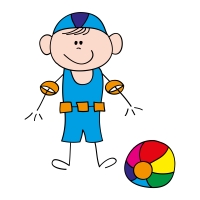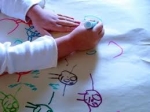Cognitive behavioral play therapy is a type of play therapy which merges the traditional and very successful Cognitive Behavioral Therapy with Play Therapy. Cognitive Behavioral Therapy - CBT is based on the assumption that what you think affects how you feel and what you do. The research base for CBT and its benefits are lengthy. It has been used successfully with adults, adolescents, and older children. Click here to learn more about CBT. So, why not try CBT with younger children if there is so much success? Play Therapy - There are many types of play therapy and its history is extensive. However, they all have the foundation of using play as a means to:
Susan Knell began using CBT with play therapy with children in the 1990’s. She began to take traditional cognitive and behavioral strategies and adjust them to the developmental age and needs of her young clients. By adding play through puppets, dolls, art materials, toy cars and sand boxes, for example, she has been able to offer another treatment option for younger children. Exactly how can we use CBT and Play Therapy? CBPT could help an aggressive child learn new ways of coping. Using puppets and various situations that could cause a child to show aggression, the therapist uses puppets and shows other forms of acting. After the therapist has displayed a healthier way to cope the child is encouraged, via puppets, to model the healthy behavior. This technique is used to:
If you are interested in learning more about Cognitive Behavioral Therapy please click here. What types of problems is CB Play Therapy helpful? Play therapy has been found to be an effective treatment avenue for children (Bratton, Ray, Rhine, and Jones, 2005). Specifically, CBPT has been found to be successful in treating selective mutism, anxiety disorders, separation anxiety, sexual abuse, sleep problems, acting out behavior, and the effects of parental divorce (Knell, 1993a; Knell, 1993b; Knell, 1999; Knell, 2000; Knell and Darsari, 2006; Knell and Ruma, 1996, 2003). By implementing play with CBT techniques, CBPT gives an opportunity to work with younger children and to offer another treatment option. What does Cognitive Behavior Play Therapy look like? In the beginning the therapist may choose to meet with just the parents to complete a clinical interview, gather history, orientate them to CBPT, and to provide psych-educational material. Within this interview the therapist may assist parents in introducing their child to therapy. When the child is introduced to CBPT and therapy begins, the therapist will gage the child, the issues, and decided on direction. The first task within CBPT is to make sure the child understands the therapy.
In CBPT the goal is for the therapy to be directed by both the therapist and the child. However, the direction can look differently with each session depending on the issues, the goals for therapy, the child’s developmental level, what is happening in the child’s life currently, and the personality of the child. Sessions will last up to 40 minutes depending on the child with 10 minutes for the therapist, child, and parents to review the session and to determine homework for the coming week. It is very important that the child and parents work on tasks from play therapy in their home environment. These tasks helps the child move skills from the play therapy room to his or her life. Cognitive Behavior Play Therapy is:
CBPT values and fosters a positive therapeutic relationship as a way for the child to feel safe, to express his or herself, and to work through difficult struggles. Why choose CBPT for my child? Children spend a great deal of time playing and there is an important developmental reason for this... Children learn through play! Children can: a. Learn about their world through play b. Play to model behaviors shown to them c. Process what is happening in their lives through play d. Experiment through play e. Develop many skills through play. Play is an important vehicle for children to not only discover, but to review and move forward in their development. How can I help as a parent or guardian? Parents please take time to play with your child or children. Take 15 minutes a day to let them decide what you are going to play with and allow them to direct the play. You will be amazed at what you learn from your child or children. Play can open doors you would never expect and allow communication between you and your child in a non threatening way. Where can I learn more about CBPT? The following resources are helpful if you wish to learn more about CBPT: Bratton, S., Ray, D., Rhine, T., & Jones, L. (2005). The efficacy of play therapy with children: A meta-analytic review of the outcome research. Professional Psychology: Research and Practice, 36(4), 376-390. Drewes, A. A. (2009). Blending play therapy with cognitive behavior therapy. New Jersey: Wiley. Knell, S. M. (1993a). Cognitive behavior play therapy. Northvale, NJ: Jason Aronson. Knell, S. M. (1993b). To show and not tell: Cognitive-behavior play therapy in the treatment of electivmutism. In T. Kottman and C. Schaefer (Eds.), Play therapy in action: A casebook for practitioners (pp. 169-208). Northvale, NJ: Jason Aronson. Knell, S.M. (1999). Cognitive behavioral play therapy. In S.W. Russ & T. Ollendick (Eds.), Handbook of psychotherapies with children and families (pp. 385-404). New York: Plenum. Knell, S.M. (2000). Cognitive behavior play therapy with children with fears and phobias. In H.G. Kaduson & C.E. Schaefer (Eds.), Short term therapies with children (pp. 3-27). New York: Guilford. Knell, S.M., & Dasari, M. (2006). Cognitive behavioral play therapy for children with anxiety and phobias. In H.G. Kaduson & C. E. Schaefer (Eds.), Short-term therapies with children (2nd ed., pp.22-50). New York: Guilford. Knell, S. M., & Ruma, C.D. (1996). Play therapy with sexually abused children. In M. Reinecke, F. M. Dattilio, & A. Freeman (Eds.), Cognitive therapy with children and adolescents. A casebook for clinical practice (pp. 367-393). New York: Guilford. Knell, S. M., & Ruma, C. D. (2003). Play therapy with a sexually abused child. In M. Reinecke, F. M. Dattilio, & A. Freeman (Eds.), Cognitive therapy with children and adolescents. A casebook for clinical practice (2nd ed., pp. 338-368). New York: Guilford. |
|
Home International Adoption Psychological Assessment Contact Anne Privacy Policy Site Map |




 ” written
by Nemiroff and Annuziata. It is a great book for explaining play therapy and what therapy
will look like to a child.
” written
by Nemiroff and Annuziata. It is a great book for explaining play therapy and what therapy
will look like to a child.
